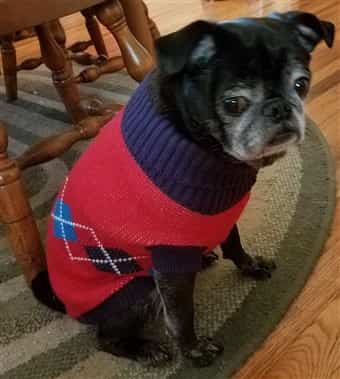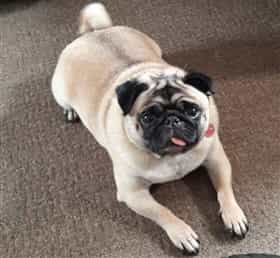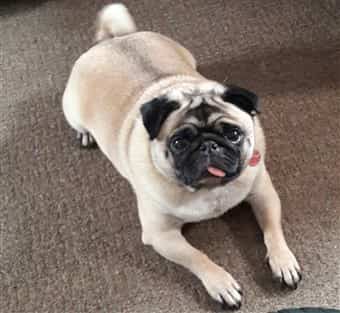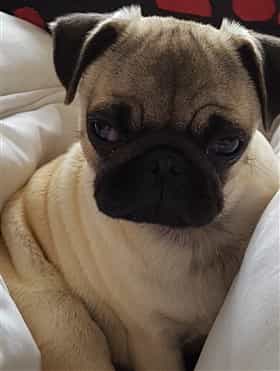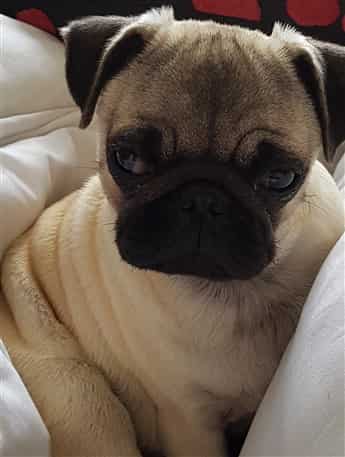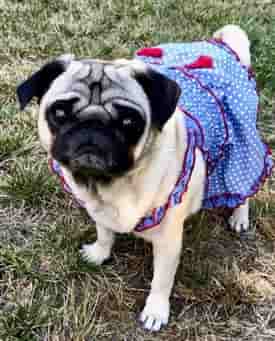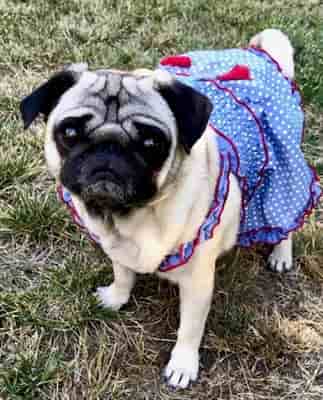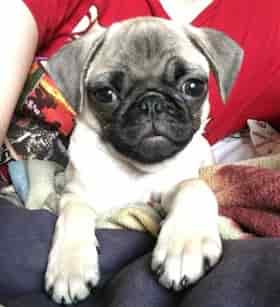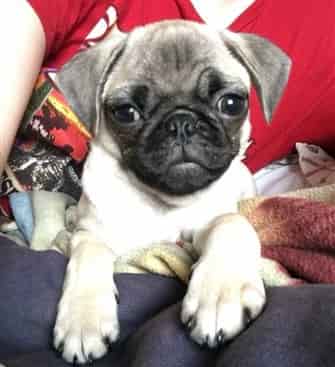Pug Dog Paw Care
Overview
A Pug’s paws are often an overlooked part of the body, despite the fact that they put up with so much. Between hot walking surfaces in the summer, frozen ground in the winter, and coming into contact with a wide range of outdoor elements, paws can really take a beating.
It’s not uncommon for paw pads to become dry, which is just a step away from peeling and cracking. And, itching is a common issue seen with the paws. In addition, tiny cuts, splinters, and irritation from contact allergen triggers are all possible elements to be aware of.
This section will help you understand your Pug’s paws and cover exactly what you can do to keep them super healthy with moisturized skin and good traction.
Please note:
PetPugDog is reader-supported, and some of the product suggestions on this page may be affiliate links. As an Amazon Associate we earn from qualifying purchases. This is at no extra cost to you and helps keep this site running.
The 10 Most Common Pug Paw Issues
#1. Dry Paw Skin.
What happens:
Paws can dry out for a number of reasons:
- Daily walking on warm, dry, or rough surfaces.
- Exposure to arid wintertime air with or without contact with cold walking surfaces.
- Reaction to irritants on the ground.
- Slight dehydration from inadequate water intake.
Once paws are dry, there can be lots of itching. This can cause a Pug to lick or bite at the paws and the saliva that is deposited often exacerbates the problem.
If dryness is not resolved, this can spiral into peeling or cracking, which can be quite painful and leaves the skin open and vulnerable to infection.
What to do:
1) Encourage your Pug to meet their water intake requirements which in general are 1 ounce of water for each 1 pound of body weight
2) Check the paws regularly to spot any early signs of dryness
3) Use products to protect the paws or moisturize the paws and/or relieve itching (if needed). Details are ahead under Recommended Paw Protection and Treatment.
# 2 Burns in the Summertime
What happens:
It’s very easy for a Pug to receive burns on the paws because sidewalks and roads commonly heat up to temperatures that dogs cannot safely tolerate. A dog’s pain threshold is 120 F (49 C) and burns will develop when the paws touch surfaces of 130 F (54 C).
But, can your Pug’s walking route really get that hot? The answer is yes. On sunny days of just a pleasant 77 F (25 C), walkways can easily reach 125 F (52 C).
Blacktop pavement, which is used for many roadways and sidewalks, heats up extremely fast and can reach up to 140 F (60 C) on hot days. This is enough to burn a Pug’s paws within 3 seconds. Red brick and cement can reach over 120 and up to 135 F (57 C).
What to do:
1) Protect your Pug’s paws by applying a quality paw protection wax about once a week. For details, look ahead to Recommended Paw Protection and Treatment.
2) If there are burns on the paws, first degree burns can be treated at home with a salve (details are ahead under Recommended Paw Protection and Treatment). More serious burns will need to be treated by the veterinarian.
3) On hot sunny days, avoid taking your Pug for walks during the hottest part of the day. It’s best to schedule walks before 10 AM or after 5 PM.
4) When possible, have your Pug walk on grass which is not able to reach high surface temperatures.
5) To test walking surfaces, carefully place your palm down. If you cannot comfortably hold it there for 5 seconds, it’s too hot for your Pug.
Cuteness break!
Peanut, at 10 years old, photo courtesy of Keri Andrade
#3 Reaction to Contact Irritants
What happens:
Spring through fall, there are allergens in the air that settles down on the ground, right where you Pug’s paws will come into contact with them. This can cause the paws to become itchy. And, if allergens stay on the paws, this can trigger other allergic reactions such as runny eyes, sneezing, wheezing, and more.
Lawn care chemicals such as fertilizer, pesticides, and weed killer can be extremely irritating to the paws and cause itchiness. Note that even if you do not use those sorts of chemicals at your own home, there can be run-off from neighboring yards and these can be used by city municipal services (who often remove warning flags long before residue finally wears away).
In the winter, ice melt products can cause chemical burns and rough grits of sand can be harsh on paw skin. Even if you do not use these products at your own home, they can be tracked in from vehicles that drive through your neighborhood.
What to do:
1) After coming inside, wash your Pug’s paws off. If you are using a paw wax, pollen, lawn care products, and other irritants may be stuck to that ‘shield’; you’ll want to rinse the paws so that these are not tracked into the house.
2) Use pet-friendly lawn care products in your yard.
3) Use pet-friendly ice melt products like around your home like Safe Paw Non-Toxic Ice Melter .
.
4) Take note of any signs that alert the public to grass treatments and keep your Pug from those areas. Remember where these are and even after signs are removed, avoid those places for at least one month.
5) Regularly apply a quality paw wax to offer a layer of protection from all of these outdoor elements. For details, look ahead to Recommended Paw Protection and Treatment.
6) If paws are irritated and/or itchy, use products to offer fast relief. For details, look ahead to Recommended Paw Protection and Treatment.
#4 Yeast Infection (Itchy, Smelly Paws)
What happens:
Some types of yeast are always present on a dog’s body, including the paws. However, under certain circumstances, this yeast can multiple. If they grow in population enough, this is referred to as a yeast infection.
One thing that can lead to yeast multiplying on the paws is when the areas between the toes (where it is dark and warm) stay damp (after a bath or after walking outside on dew, through puddles, etc.).
Signs of a yeast infection on the paws includes severe itchy and a strong odor. The odor may be an overpowering smell that reminds you of old wet socks (a musty smell).
What to do:
1) If you are not sure of the diagnosis of a yeast infection on the paws, bring your Pug to the vet to have this confirmed.
2) If you are rather sure that yeast is the problem, treating the paws with an anti-fungal spray that contains chlorhexidine and ketoconazole can usually clear this up. For details, look ahead to Recommended Paw Protection and Treatment.
3) To help avoid this from happening again, dry off the paws, including between the toes, after baths and any time that the paws get wet when your Pug is outside.
Cuteness break!
Peggie, at 4 years old, photo courtesy of Susi R Ludlow
#5 Snowballing .
What happens:
This is a wintertime issue. When a dog walks on snow, it gets pushed in between the toes and in between the paw pads. It then melts due to body heat. But, if it is really cold out, some of that melted snow can then refreeze into ice. The ice expands as it freezes and can stretch the skin. This can cause quite a bit of discomfort and, if severe enough, skin can crack.
What to do:
Regularly applying paw protection wax will stop this from happening. For details, look ahead to Recommended Paw Protection and Treatment.
#6 Unexplained Itchiness
What happens:
Your Pug’s paws are incredibly itchy, causing your guy or gal to continually gnaw at, bite at, or lick the paws. But, you can’t figure out what in the world can be causing the problem.
Chances are, it is one of the elements already covered: Pollen, lawn care products, dry paw skin, minor burns from hot walking surfaces, dry and cold walking surfaces in the winter, or even the beginnings of or a minor yeast infection (not quite severe enough to emit the classic musty smell).
This said, there are other possible reasons including reaction to cleaning products in the home or laundry detergent that was used to wash bedding or other items the paws come into contact with. The itching may have initially started due to an insect sting, minor cut that went unnoticed, or any number of things. In these cases, the original issue resolved, but, the licking aggravated the area and now it’s become its own problem.
What to do:
1) Look to the various issues listed here to see if you can identify the culprit and, if so, follow the tips to resolve the problem.
2) If you are unable to identify the element that started the issue, there are still ways to help your Pug including anti-itch sprays that can offer immediate relief. For details, look ahead to Recommended Paw Protection and Treatment.
Cuteness break!
Alfie, at 6 months old, photo courtesy of Sharon Edwards
#7 Slipping, Loss of Traction
What happens:
If the paw pads are in bad shape, a dog will have decreased ability to grip as he walks. Alternatively, young pups and adult dogs that stay indoors may have an issue with paw pad skin being too smooth; this is something that toughs as a dog walks on a variety of surfaces.
Older, senior dogs may have less traction due to the aforementioned issues often coupled with decreased vision that leads to accidents.
What to do:
1) Regularly apply a paw protection wax. There are many benefits to this, including better traction. You won’t want to do step #2 (next) without first doing this, since allowing damage to the paws will have your Pug in an even worse situation.
For details, look ahead to Recommended Paw Protection and Treatment.
2) Once paws are protected with wax, gradually introduce your Pug to a variety of walking surfaces. This includes grass, sand, pavement, rocky areas, and padded forest trails.
3) If your Pug is really slipping a lot, do not allow them to run off leash or navigate tricky areas without your assistance. Keep your Pug on leash and harness
(not a collar) when outdoors. While harnesses are always recommended for brachycephalic breeds due to breathing issues linked to collars, an additional benefit is that the harness will allow you to ‘catch’ your Pug without injuring the neck.
If you are looking for a good harness for your Pug that is comfortable and very easy to put on, a great one is the Puppia Soft B Harness Vest
 .
.
4) If you have a senior Pug that slips on smooth flooring or steps, consider placing down non-slip grip rugs and/or setting up a gate at the top of a staircase to prevent accidental falls.
#8: Cracked Paw Skin
What happens:
When a Pug dog has cracked paws, it always began with a less serious issue that may have not been noticed. This may have been a bad case of dry skin, a cut, snowballing, chronic irritation with contact irritants, etc. So, it’s always a good idea to look back and see if you can identify likely culprits in order to avoid them in the future.
What to do:
1) If the cuts are actively bleeding, puss is oozing out, and/or your Pug appears to be in moderate to severe pain, this warrants a vet visit. The vet can flush out the area, prescribe antibiotics, possibly prescribe anti-inflammatory meds, and professionally wrap the paws.
2) To treat minor to moderate cases at home that do not show the aforementioned signs, a healing cream may resolve the issue. Depending on the severity of the cracks, improvement may be seen within just days and full healing within a week or two. For details, look ahead to Recommended Paw Protection and Treatment.
Cuteness break!
Charlotte, a rescue Pug at 3 years old, photo courtesy of Lynn Klopfenstein-Crausman
#9 Sores on the Paws Due to Lick Dermatitis
What happens:
Lick dermatitis, also known as lick granuloma, is due (in most cases) to compulsive licking and is a condition in which there are sores, localized inflammation, and possibly hair loss. This can happen on any area of the body that a dog can reach, but is commonly seen on the paws due to these body parts being so easily accessible.
A wide variety of factors may be to blame for the initial licking, most have been covered here. However, in some cases, emotional issues such as severe stress or boredom can cause a dog to obsessively lick his paws.
Lick dermatitis is difficult to treat because as long as a dog continues to lick the paws, it is near impossible for sores to heal.
What to do:
1) Moderate to severe cases should be treated by the veterinarian. Treatment will involve antibiotics, the use of a safety collar to stop any further licking, and laser surgery (in some cases). Dogs that lick their paws due to stress may be prescribed anti-anxiety medication.
2) If your Pug has a minor sore and/or compulsive licking that you worry may lead to lick dermatitis, there are some things you can do from home:
Look to all possible itching triggers (listed throughout this article) including pollen, chemicals, etc. to avoid further irritation.
Use an anti-itch spray to offer soothing relief. For details, look ahead to Recommended Paw Protection and Treatment.
Until the area heals, wrap the area with gauze, slip on a sock or paw bandage, or place a safety collar on your Pug.
#10 Minor Injuries
What happens:
Slivers on the bottom of the paws and pebbles that get stuck between paw pads are not uncommon with dogs. And, small cuts may also occur.
What to do:
1) Any limping, favoring a paw, or signs of discomfort should be evaluated asap.
2) Pebbles can be removed with tweezers. It’s always best to have a helper hold your dog while you carefully remove the stone.
3) If there is a sliver, you can try to remove it with tweezers; however, if you cannot reach it, this warrants a vet visit.
4) For minor cuts, wash the paw with water and dish soap, pat dry, apply a dab of antibiotic gel, and cover with a paw bandage. Moderate cuts or those that do not stop bleeding should be treated by the veterinarian.
Cuteness break!
Gus Gus, at 4 months old, photo courtesy of Mary
Recommended Paw Protection and Treatment
Now that we’ve covered just about everything that can go wrong with the paws, let’s take a look at what can make this right.
Paw Wax:
This is the one paw product that you’ll want to use year-round. A quality paw wax will offer a layer of protection from walking surfaces and serve as a shield against irritants. It will also keep paw skin properly moisturized and help resolve drying, peeling, or cracking. Additionally, it will help your Pug have good traction.
This is one of the best paw waxes available. It offers an effective layer of production while allowing the paws to ‘breathe’. It also absorbs rather quickly and does not have an odd smell. This should be applied every 7 to 10 days, and it’s often best to do this at night right when your Pug is getting ready to sleep. Be sure to massage this into the entire paw pad, including in between the toes.
Anti-itch Spray:
An anti-itchy spray can offer immediate relief for minor to severe itching. When possible, it’s recommended to go with a non-medicated product since dogs can so easily reach and lick their paws. However, if your Pug does require a medicated spray, you can slip on a paw bandage.
This is a great spray that has two of the best all-natural anti-itch elements: baking soda and oatmeal. This can be used up to 4 times per day, with the final application done right at your Pug’s bedtime.
Top choice, medicated: SynergyLabs Veterinary Formula Medicated Spray .
.
If your Pug’s paws are so itchy and irritated that it’s driving your dog bananas, you may want to opt for a very strong medicated spray. This one has hydrocortisone which is very effective for itching and inflammation and lidocaine which is very effective numbing agent.
This can be applied up to 4 times per day and be sure to cover your Pug’s paw(s) with a paw bandage (see next) so that this cannot be licked off.
Paw Bandages:
A paw bandage is very helpful when you want to stop your Pug from licking a paw, to keep treatments like salves or antibiotic gel on the paw, or to cover a cut or injury.
This is a great bandage that comes in a range of sizes, starting at x-x-x-small for super young puppies and goes up from there. It is paw-shaped and easy to secure with an adjustable Velcro strip. The gauze is breathable and it stays in place very well.
Anti-Fungal Spray:
If your Pug has a yeast infection on the paws, it will be time to resolve this with an anti-fungal spray. Though, keep in mind that stubborn infections may need to be treated by the vet via oral anti-fungal medication.
This spray is effective with its powerful combination of chlorhexidine and ketoconazole. This should be sprayed onto the paws 3 times per day and be sure to thoroughly reach all areas in between the toes.
It’s best to allow the paws to be free of socks or gauze while the yeast infection is rampant and this normally dries in about 10 minutes. However, if your Pug tries to lick this all off, you’ll want to slip on a breathable paw bandage (see previous item).
Healing Cream:
While a good paw wax can help heal peeling and cracking, for moderate to severe cases, you may want to use a restorative cream. This sort of product is also good for healing burns.
This has a terrific blend of organic shea butter, joboba oil and hemp seed oil, which work together to offer rapid soothing and quick healing.
And, we just had to do one more cuteness break!
Daisy Mae, Ellie Mae, and Kirby, photo courtesy of Rhonda Peoples



